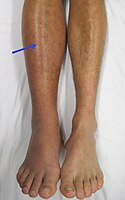
Photo from wikipedia
Dear Editor, Paroxysmal nocturnal hemoglobinuria (PNH) is an acquired clonal disorder of hematopoietic stem cell characterized by mutations in the PIGA gene leading to complementmediated lysis [1]. Approved in 2009,… Click to show full abstract
Dear Editor, Paroxysmal nocturnal hemoglobinuria (PNH) is an acquired clonal disorder of hematopoietic stem cell characterized by mutations in the PIGA gene leading to complementmediated lysis [1]. Approved in 2009, eculizumab is the first specific treatment for PNH [2]. Nevertheless, this treatment remains only symptomatic and does not lead to the disappearance of the PNH clone. Although spontaneous remissions have been reported to occur in up to 15% of cases [3], the involved mechanisms are not yet fully understood. We describe here a patient in whom PNH remission occurs with the emergence of a new sub-clone in the context of a preexisting myelodysplastic syndrome (MDS). A 71-year-old man was referred because of anemia evolving since 2014. In April 2015, complete blood count results were as follows: white blood cells (WBC) 3.7 × 10/L, hemoglobin 9.6 g/dl with normal mean corpuscular volume, reticulocytes 113 × 10 L, and platelets 140 × 10/L. The martial record was in favor of an iron deficiency (ferritin 17 μg/L, serum iron level 8 μmol/L, transferrin saturation coefficient 11%) together with biological stigmas of hemolysis (LDH 985 UI/L and haptoglobin undetectable). The direct and indirect antiglobulin tests were both negative. A flow cytometric analysis was performed on peripheral blood leucocytes and revealed a PNH neutrophil clone quantified at 33%, which is consistent with the literature [4]. Bone marrow smears analysis was performed and showed an erythroblastic hyperplasia and dysplastic erythroid progenitors without blasts excess (Fig. 1a). Cytogenetic analysis disclosed a clone with a deletion of chromosome 13 (46XY, del(13)(q13q21)) (Fig. 1b). In addition, molecular analysis performed by next-generation sequencing found two somatic hotspot mutations: U2AF1 p.(Ser34Phe) andDNMT3A p.(Arg736Cys). Eculizumab therapy started in May 2015. PNH clone size was monitored regularly and gradually decreased until reaching the size of 0.81% in February 2018 (month 34) leading to eculizumab discontinuation. Hemoglobin level re-increased and the last transfusion was performed in July 2019 (month 51). Concerning MDS evolution, molecular analysis in 2017 (month 31) revealed a novel mutation of the ASXL1 gene (c.1933_1934delGG) in addition to those already known. Because of its localization in a region of guanine nucleotide repetition where sequencing errors can occur, this mutation was confirmed and quantified with a fragment analysis approach. Previous bone marrow aspiration samples were retrospectively analyzed and the ASXL1mutation was not detected
Journal Title: Annals of Hematology
Year Published: 2020
Link to full text (if available)
Share on Social Media: Sign Up to like & get
recommendations!